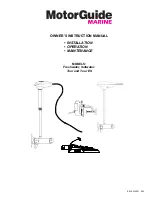
33
On
On
On
-
-
-
Chip Primary / Secondary PCI IDE
Chip Primary / Secondary PCI IDE
Chip Primary / Secondary PCI IDE
These options allow you to enable / disable the onboard IDE interface.
IDE Primary/Secondary Master/Slave PIO
IDE Primary/Secondary Master/Slave PIO
IDE Primary/Secondary Master/Slave PIO
The four IDE PIO (Programmed Input/Output) fields let you set a PIO mode (0-4)
for each of the four IDE devices that the onboard IDE interface supports. Modes 0
through 4 provide successively increased performance. In Auto mode, the system
automatically determines the best mode for each device.
IDE Primary/Secondary Master/Slave UDMA
IDE Primary/Secondary Master/Slave UDMA
IDE Primary/Secondary Master/Slave UDMA
Ultra DMA implementation is possible only if your IDE hard drive supports it and
the operating environment includes a DMA driver (Windows 95 OSR2 or a third-
party IDE bus master driver). If your hard drive and your system software both
support Ultra DMA, select Auto to enable BIOS support.
USB Controller
USB Controller
USB Controller
This field allows you to enable or disable the onboard USB controller.
USB Keyboard Support
USB Keyboard Support
USB Keyboard Support
If you are using the Legacy OS (such as MS-DOS) and you’re-installing a USB
keyboard, please select "Enable" in this field. For PnP O/S like Windows 98,
Windows 2000, Windows ME … etc, you should select the default setting.
Init Display First
Init Display First
Init Display First
When you have both onboard AGP and PCI VGA card installed in your system, you
can use this field to decide the display loading priority during system startup.
memory to store 3D texture mapping data to increase the video display perform-
ance. The field allows you to define the memory size which you prefer to use for
the AGP Port. The memory size selectable is either "Disable" or 32MB or 64MB
DVMT. When you select 64MB DVMT, it allows the maximum 64 MB memory
which Windows 95/98 can use to store the 3D texture.
When you select the 64MB DVMT, you will see 1024K memory is allocated as the
shared memory when you power on the PC system. When you start the Windows
operation system, Windows will automatically allocate the required display share
memory dynamically.
BI
OS
BI
OS
BI
OS
BI
OS
BIOS Setup
BIOS Setup
3.6 Integrated Peripherals
3.6 Integrated Peripherals
3.6 Integrated Peripherals
(The
Integrated Peripherals
Menu is on the following page)












































